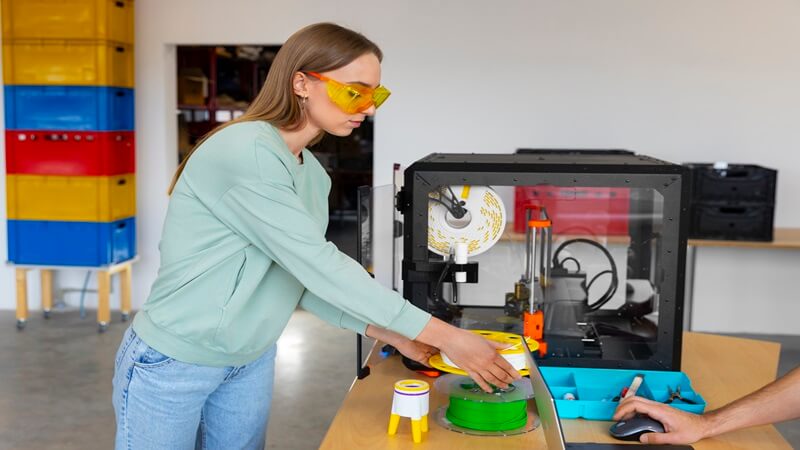The advent of 3D printing technology has marked a new era in manufacturing, prototyping, and even art. The capacity to translate digital models into three-dimensional objects holds vast potential for countless industries. Behind the scenes of this technological marvel, the function of high-quality gases such as argon gas, helium, and others, is often overlooked, despite being crucial to the functionality and progression of 3D printing technologies. In this exploration of 3D printing advancements, we delve into the role of these gases in enhancing the process and producing superior results.
Understanding the Need for High-Purity Gases in 3D Printing
The precision of 3D printing relies not only on the accuracy of digital design but also on the purity of the materials utilised, including gases. These specialised gases serve various purposes, from creating inert atmospheres to prevent oxidation during the melting of metal powders, to powering lasers that fuse the material layers together. The use of high-purity gases like argon ensures that the integrity of the build material remains uncompromised, which is essential for achieving the desired quality and strength of the final product.
The Critical Function of Laser Gas in Additive Manufacturing
Among the critical inputs for 3D printing, particularly in the realm of metal sintering, is laser gas. This type of gas is instrumental in the operation of the high-powered lasers that are central to many 3D printing processes. The function of these lasers is twofold: they selectively melt and fuse powdered materials according to the design specifications, and they also help sculpt objects with impressive accuracy and detail. The control and stability that a quality laser gas provides are paramount to the successful realisation of complex geometries and designs.
Helium Gas: A Supporting Player in 3D Print Quality
Another gas that plays a significant role in 3D printing technologies is helium. As a coolant, its high thermal conductivity and inert characteristics make it ideal for maintaining appropriate temperatures during printing, which prevents warping and ensures dimensional accuracy. It’s also used in some laser-based printing methods to keep the optics clean. The role of reliable helium tank suppliers is vital in ensuring a steady supply, which allows for consistent quality control in 3D printed products.
The Importance of a Steady Gas Supply Chain
Manufacturers rely on a consistent and uninterrupted gas supply to maintain their 3D printing operations. Any disruption can lead to costly delays and compromised product integrity. Thus, partnerships with dependable suppliers of these gases become an essential component of the additive manufacturing industry. Companies that can deliver these gases in various quantities – from small cylinders for prototyping to large bulk deliveries for industrial-scale productions – are invaluable to the smooth operation of the 3D printing process.
Argon Gas: Ensuring a Contamination-Free Printing Environment
For many printing applications, especially ones involving metals, maintaining an inert atmosphere is crucial. Argon gas is often the preferred choice for this purpose owing to its non-reactive nature. It acts as a shield for sensitive materials, preventing oxidation and other chemical reactions that could compromise the structural integrity. The presence of argon gas can mean the difference between a flawed part and a flawless one, showcasing the significance of its role within the 3D printing landscape.
Expanding Horizons: 3D Printing in Aerospace and Medicine
Specific industries, such as aerospace and medicine, are already benefiting immensely from the capabilities of 3D printing. Thanks to the level of precision and the ability to produce strong, lightweight components, aerospace companies are turning to additive manufacturing for parts that can address the unique demands of space and air travel. The suitability of the gases used in these highly specialised applications is essential, as any deviation from the required purity standards can have significant repercussions.
Environmental Considerations and Sustainable Practices
With global attention focused on environmental sustainability, it is imperative for 3D printing processes to consider their ecological impact. Steps are being taken to reduce waste in the production process, and the efficient use of gases is a part of this movement. By using the appropriate amount of gas, minimising leaks, and ensuring proper disposal or recycling of gas containers, 3D printing can continue to grow as an eco-friendly manufacturing option.
Custom Gas Mixtures for Unique 3D Printing Applications
As 3D printing technologies evolve, so do the gas mixtures required to optimise these processes. Some applications may require custom gas blends that can deliver unique performance characteristics. Suppliers that offer specialised gas mixtures and who can work closely with manufacturers to develop solutions tailored to their needs will become increasingly valuable as 3D printing technologies continue to expand into uncharted territories.
Conclusion: Integrating Gases and 3D Printing for Future Innovations
In conclusion, the interconnectedness of specialist gases such as laser gas, helium, and argon with 3D printing technology is a defining aspect of current and future innovations. While the visible elements of 3D printers often capture the spotlight, it’s the invisible gases that help fuel advancements and push the envelope of what can be achieved. By understanding and sourcing the right gas solutions, the potential for 3D printing to revolutionise production across various sectors remains boundless. As we gaze into the future, the collaboration between gas suppliers, engineers, and innovators will undoubtedly lead to further breakthroughs that harness the transformative power of additive manufacturing.
The gas solutions that power 3D printing advancements are not just a footnote in the story of this technology; they are a critical component that underscores the intricate balance between innovation and practical application. Whether in design studios or on the manufacturing floors, ensuring access to high-quality gases and reliable suppliers will continue to be an integral part of 3D printing’s evolution and success.
